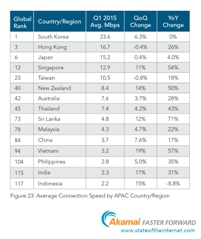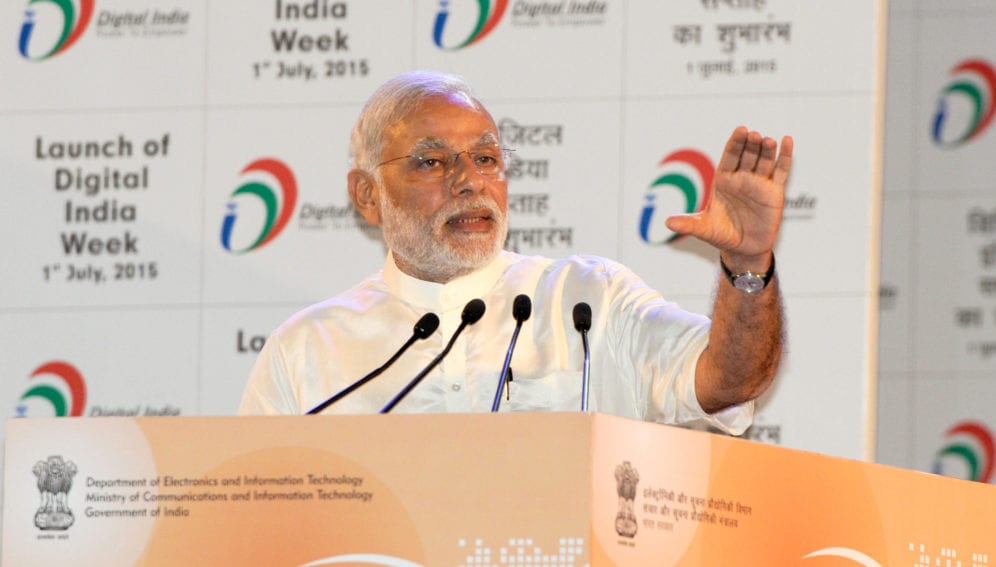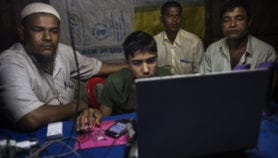By: Ranjit Devraj
Send to a friend
The details you provide on this page will not be used to send unsolicited email, and will not be sold to a 3rd party. See privacy policy.
The ‘Digital India’ plan launched by Premier Narendra Modi on 1 July will link 250,000 Indian villages by 2019, says Ranjit Devraj.
Described as India’s first cyber prime minister for his massive presence on social media, Modi says he dreams of an India driven by 1.2 billion connected people. Modi’s is no idle dream. The US$ 18 billion that the government plans to invest in Digital India is more than matched by pledges worth US$ 71 billion made at the launch by India’s cyber czars. With that level of investment Digital India has a chance of succeeding where previous attempts to connect an appreciable percentage of the Indian population, and bridge the digital divide, floundered.




As things stand, India ranks a low 115th for average Internet speed among countries studied this year by Akamai Technologies. The government has plans to provide affordable broadband connectivity at 20 Mbps to every household by 2019, but what is already working is India’s impressive expansion of mobile phone ownership. Some 70 per cent of the country’s 250 million Internet users access the Web via mobile phones and hence, the new emphasis on m-governance rather than e-governance.
Apart from broadband connectivity in the villages, Digital India envisages free Wifi in all educational institutions and also in major urban centres by 2019. This year BSNL, a government telecom company, will create 250 WiFi hotspots. The initiative ticks boxes in areas like health, education, agriculture and banking. Digital infrastructure is to become a utility available to every citizen — or so the vision statement goes.
Modi plans to leverage India’s acknowledged strengths in providing software solutions to move into the manufacture of hardware — currently India’s largest import item after petroleum. He is betting that the vast investments in Digital India will boost local manufacture, create infrastructure and generate employment. “Why can't we make quality electronic goods that are globally competitive?" was Modi’s challenge to the corporate honchos who attended the launch.
Private investors
The CEOs took up the challenge. Anil Agarwal, chief of Sterlite Technologies Ltd., said his company has plans to set up a US$ 6.3 billion facility to manufacture LCD panels and generate employment for 40,000 people. Sunil Bharti Mittal, chairman of Bharti Airtel, India's largest mobile phone operator, said his company plans to build on India's already extensive telecom network and spend over US$ 17 billion in the next five years on affordable services and handsets. Kumar Mangalam Birla said his Idea Cellular mobile services company will tap into its subscriber base of 165 million users to provide mobile-based healthcare and education services plus weather forecasting advisories and market prices to reach a million farmers. Birla plans to invest US$ 2 billion over the next five years in electronic manufacturing, energy storage, Internet of Things and smart cities, creating a million new jobs in the process.
Government initiatives under Digital India are impressive and include services such as a digital locker to store and transfer documents over dedicated personal space in the cloud for all registered citizens. But what will make such initiatives work is the public-private partnership. The Reliance Group (RG), India's largest provider of data centre facilities, plans to launch schemes to encourage its 300 million clients to avail of the digital locker. RG, owned by Anil Ambani, will invest US$ 1.5 billion to fund transformational initiatives across cloud, digital and telecom and have in place by yearend India’s first Cloud Delivery Network.
The biggest investor by far in Digital India is Anil Ambani’s older brother Mukesh Ambani whose Reliance Industries Ltd (RIL) is coming in with US$ 40 billion and a promise to employ 500,000 people. RIL’s plans include the funding of start ups by young entrepreneurs capable of advancing Digital India projects.
Transparency and security
What could hold up this grand vision of open governance and ready digital access? For one thing, too much has been invested by both governors and the governed in opaqueness. The digitising of government files is unthinkable in the foreseeable future. For citizens, the lack of adequate laws to protect privacy and data has led to suspicion that the technology will work to the advantage of government and its corporate partners. The digital locker cannot, for example, be accessed by citizens who have not opted to have ‘Aadhar’, the government-issued biometric ID card. The compulsory use of the card has been successfully challenged in the Supreme Court. One of the criticisms against Aadhar — and this is bound to extend to the digital locker — is that the citizen is helpless against data pilferage or misuse.
Modi, however, sees opportunity for Digital India in security issues which he called a “bloodless war hovering over the world.” India, he believes, could play a role in providing a “shield to the world by providing innovative and credible solutions” for security.
Ranjit Devraj is SciDev.Net’s Regional Coordinator for South Asia.
This article has been produced by SciDev.Net's South Asia desk.














